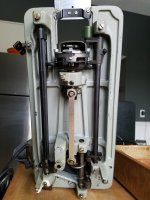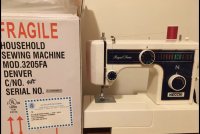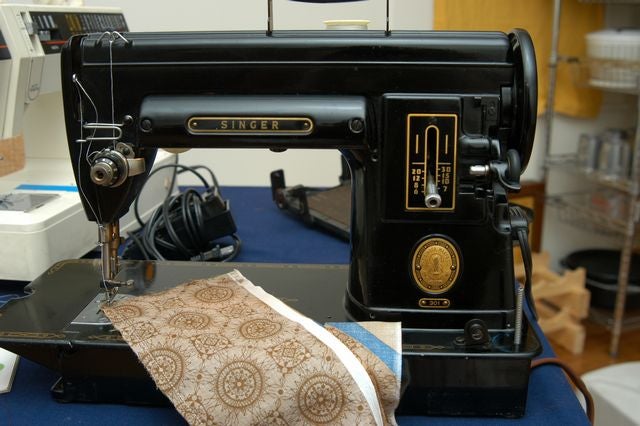Whew, there's so much to learn at about all the machines out there but I'll hit the highlights.
If you are going to do a lot of leather sewing then it's worth it to get a commercial machine. But I don't think you are and commercial (industrial) machines are large, heavy and expensive. And they mostly do straight stitching. The sturdy, well engineered and built machines from the 50's and 60's can handle leather and sailcloth, but not all day every day like the commercial machines. But even after decades of use, these sturdy home oriented machines will outperform and outlast new machines.
(Some commercial machines have an actual oil pan to keep things constantly lubed, home machines need regular oiling which is why oil loaded plastic gears crept in to make them maintenance free- until they needed repair for broken gears.)
Usually "automatic" means there is some sort of cams for decorative stitching. Some are built in, some have removable cams for a large number of stitches.
Most of the machines you'll be looking at will do both straight and zig-zag, some will have cams. Don't want 'em? don't use 'em. It can be tricky to implement double needle sewing.
Older machines, up to about 1970, tend to be all metal, though there may be a few plastic bits, but not anywhere in the drive train. My first machine is an Italian made Singer 237 for $40 with a table. Like a lot of old machines, it needed cleaning and lubrication but now works well. You can clean with lighter fluid, then only use good sewing machine oil - Blue Creeper works well, but there are many. The Singer isn't as powerful as ones I bought soon after so it doesn't get used.
Singers have a wide range of machines, most were good to very good with a few that are excellent, but even the best pale compared to Necchi, Pfaff or Husqvarna. Elna and Bernina are also good, but on the advice of my mechanical engineer friend who has 6 Necchi, I've rounded up three of them now with a Viking Husqvarna and another Singer that was too cheap to pass up.
Pfaff are good and powerful but tend to be expensive and a bit harder to find. I've never used one.
The early 60's Viking Husqvarna 19E ($65) I have is made with a selectable reduction gear so it has more torque and is better able to handle sail cloth and yes, leather. It also has a 'free arm" which makes doing sleeves easier. Nice machine.
But, on to the Necchi. In Necchi speak, BU means the machine will do zig-zag, BF is a straight stitch machine. Models in the 40's were just called BU or BF, then they came out with the Nova, about the same but with some improvements. The next model in the 50's is the Mira, a real workhorse. There was a model with a knee lever in an alloy base called the Mira 103 that only has a 0.5 amp motor, but most have the 1.2 amp motor the rest of the Necchi have. Smooth and powerful, it will get the job done.
In 1954 they came out with the SuperNova, the first of which had no cam drive for a host of accessory cams to make decorative stitches but the later ones do. That's the little hatch in the photo below. The design and construction are so beautiful I find it hard to believe they are 15 years older than my Singer 237 which was made in 1969 and looks like it was make 15 years before the Supernova. Solid, smooth and powerful, they are a joy to use.
As far as accessories go, early Necchi are low shank, later ones are high shank. It's not hard to find feet, belts or other accessories on ebay or a good online sewing site. Some people change the motors out to even more powerful ones as the construction is so robust they can handle it.
There are a number of models that are very similar but the all have good bones. Supernova, Supernova Ultra, Nora, Julia, Miranda, Esperia. The later ones are 'improved' Supernova machines, but the improvements are mostly feature refinements that aren't critical so it's better to stick to the early ones. They did make some wild looking models like the Lydia, which is in MOMA, I think, but that's not my cup of tea. Other model names are Lelia, Mirella, Silvia, Julia.
You'll find the prices all across the map, from $40 for a beat up one, to $300 for a well cared for unit with accessories that's been well maintained. I paid $80 for my Supernova Ultra in a nice table that needed a new power cord. (no cams or manual) Not that unusual for cords to be bad, but new ones are available online. All Necchi take standard bobbins and needles, so that's excellent. Necchi didn't make any cheap machines or lesser quality units. Some had less features for a lower price, but the quality is the same.
You can check shopgoodwill.com and see if one comes up there, though they are listed as untested. I paid $26 for shipping my Husqvarna. There's also Facebook Marketplace, Craig's list, Offerup.com and a host of others. Always best to see it in person, some people don't know what they have, much like cars. Frozen ones can be freed up with heat and oil and some time.
The photo below shows a Mira on the left in a custom base with a motor control. The Supernova also has a custom base.
There's a large
Facebook group about Necchi that's pretty good. The admin runs a tight ship, there's a long FAQ she wants new members to read if you join so she doesn't spend time answering the same questions over and over.
I'll post some youtube links below of some machine videos.






